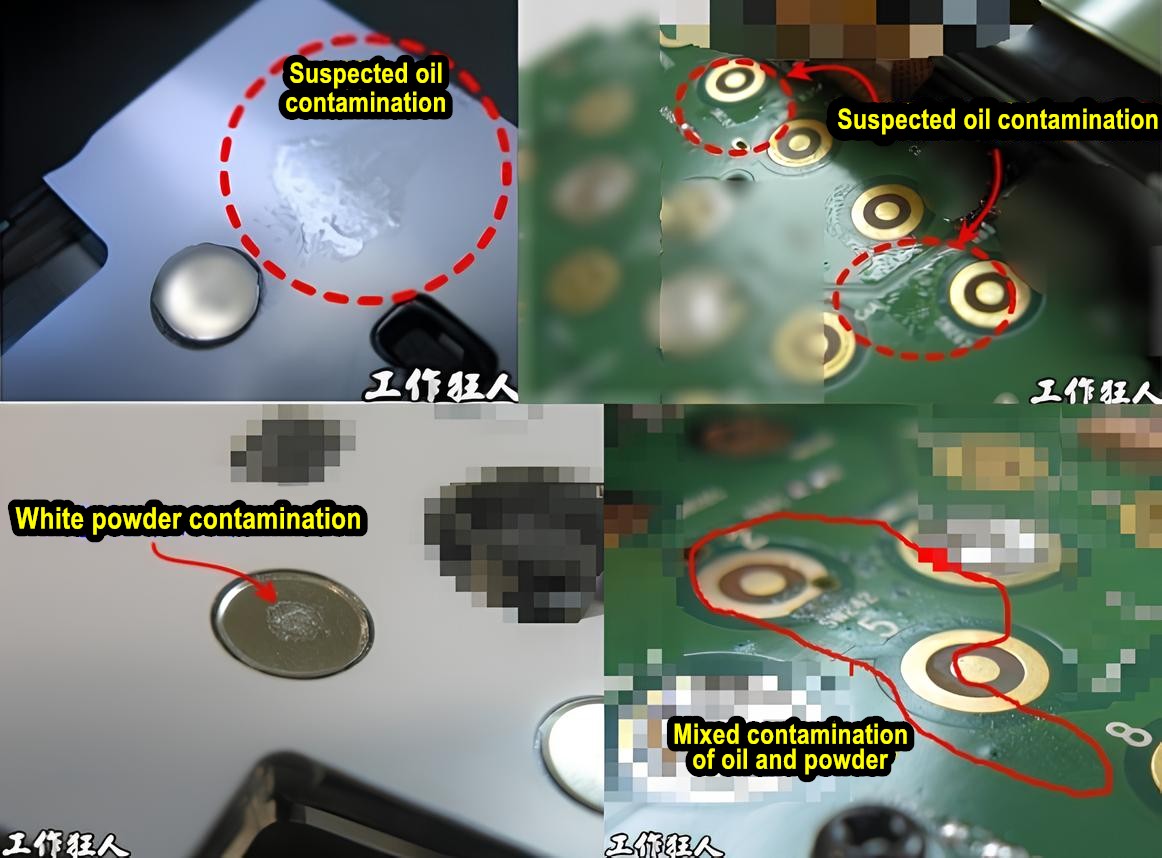
In the previous article, Workingbear mentioned a serious DOA (Dead on Arrival) customer complaint involving one of the company’s products. Most of the defective units had unresponsive keypads—specifically the 3, 6, and 9 buttons—and it was eventually traced back to oil contamination. At the time, the company formed a special task force to investigate the issue, and even sent engineers to the contract manufacturer’s factory to track down the root cause.
To be fair, the factory was quite cooperative and had already done some internal troubleshooting to rule out several possibilities.
After a thorough investigation, the most likely root cause (which some readers had already guessed in the previous article) was that a factory operator mistakenly used flux instead of IPA as a cleaning agent. The flux was wiped directly onto the gold finger traces of the keypad circuits, causing the contamination.
Related Reading: [Case Study] Troubleshooting a Customer Complaint – Keypad Malfunction Caused by Oil & Powder Contamination on the PCB
However, since this was a complaint from a major customer, it also involved repair and compensation for the defective units. So, every possible theory needed to be backed up by scientific data to close the case properly. This case started off messy and confusing, with no clear direction. But in the end, the truth came out—just like the famous quote from Detective Conan: “There is always only one truth.”
As explained in the previous article, we took a two-pronged approach to solve this issue.
-
The first approach was to send samples of the contaminated PCBs to an independent third-party lab for SEM/EDS and FTIR analysis to identify the substance. SEM/EDS only showed that the contamination was organic—it detected carbon (C) and oxygen (O), along with expected ENIG elements like gold (Au) and nickel (Ni). However, it couldn’t identify the exact compound. So we needed FTIR analysis, which works by matching the sample’s chemical fingerprint against a database. But if the compound isn’t in the database, FTIR won’t be able to identify it. That’s why it’s a good idea to also submit samples of suspected substances for comparison—only then can you truly confirm what the contamination is.


-
The second approach was to investigate every possible source of contamination at the factory. This included PCB incoming inspection, storage, SMT feeders, the entire SMT line (especially the reflow oven), hand-soldering, ICT (In-Circuit Test), FVT (Function Verification Test), repair, final assembly line—and even checking whether the anti-static air guns might be spraying oil. We left no stone unturned and basically inspected the entire factory from top to bottom.

It was a lucky break. The lab’s initial analysis showed that the contaminant contained ingredients commonly found in cleaning agents like IPA or glycol ether. However, there were still some unknown components that couldn’t be identified. Since the formula didn’t match any of the cleaning solvents normally used in the factory, we gathered everyone involved to brainstorm possible causes. Suddenly, someone asked, “What if one of the operator accidentally used flux instead of a cleaning agent?” That actually seemed quite likely.
So, we decided to send all types of flux and cleaning agents from the factory to the lab for FTIR analysis. At the same time, we asked the factory’s QA engineers to quietly observe how the workers were cleaning the PCB’s gold-finger contacts. We even simulated what would happen if someone used flux as a substitute for IPA to clean the board.
The FTIR results were exciting. In the earlier tests, we didn’t provide the lab with samples of suspected contaminants, which meant FTIR couldn’t identify some of the compounds. But after we submitted all of the fluxes and cleaning agents from the factory for comparison, one of the unknown substances in the contamination sample was confirmed to be flux. The lab believed that the contamination was a mixture of flux and cleaning agent, blended together in some unknown ratio.

This also explained why the operator didn’t immediately notice the difference between the two liquids. Normally, flux has a slightly yellow color and a different smell compared to IPA. Anyone with even a little production line experience should have been able to tell them apart. But if they were mixed together, it would be harder to notice.

The way operators cleaned the PCB keypads also varied, but in general, they dipped a cotton swab into the cleaning liquid and wiped from the rightmost button to the left, without redipping. So the buttons that received the most liquid were 3, 6, 9, and OK—which matched the pattern of keypad malfunctions.
We also simulated wiping flux directly onto the gold-finger traces of the PCB, and the resulting white powder closely matched what we saw on the defective products from the customer. However, the oily-looking contamination wasn’t fully replicated. We may need to continue experimenting with combinations of cleaning agent and flux to see if we can recreate that appearance.


The investigation is currently paused due to the U.S. Christmas holidays, but Workingbear believes the case is essentially closed. The contract manufacturer later admitted that it was indeed possible that a line operator mistook rosin (flux) for IPA. Shockingly, both the flux and IPA were originally stored in the same cabinet, side by side. Without careful inspection, it was easy for a new worker to confuse the two containers. The factory has now taken corrective actions: the two solvents are stored in separate locked cabinets, clearly labeled with different colors and warnings. Only authorized personnel, with supervisor approval, are allowed to access them to prevent future mix-ups.

Related Posts:








Very well described 👍, it seemed to me reading a thriller book hehe
Thank you for sharing